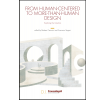From Human-centered to More-than-Human-Design. Exploring the transition
Synopsis
Released under the Creative Commons License Attribution-NonCommercial-NoDerivatives 4.0 International (CC BY-NC-ND 4.0) in the peer reviewed series Design International.
The environmental emergency of the last century, highlighted by the pandemic, has led to an urgent need to reformulate the predominant role of human beings on the planet by undertaking a less anthropocentric design approach. This urgency has been especially outlined by a re-evaluation of the concept of the Anthropocene, which can be defined as a geological era characterized by the significant human impact on the geology and ecosystems of the Earth. Within this theoretical framework, the book explores the role of Design as a multifaceted discipline capable of exploring the complexity of a changing world, and reconsiders the human being’s position in a pervasive relationship with the contemporary environments (physical and abstract) through a More-than-Human approach.
This volume illustrates reflections, analyses, and interventions guided by or intersected with the concept of the post-Anthropocene, and traces two different scales of observation. The first, explored in the two starting chapters, highlights how the complexity of the topic requires a large-scale analysis perspective in order to be fully understood. The concept of the post-Anthropocene does not exclude the human being as a fundamental component but takes the latter as a departing point to frame wider contemporary needs and issues and to support a call for action to envision and shape the future. The second part of the book instead explores the possibility to include, within this broad discussion, the theme of More-than-Human applied to specific disciplines – linked to the culture of Design – analyzing different aspects that move from taxonomy, application, and creativity.
Downloads


